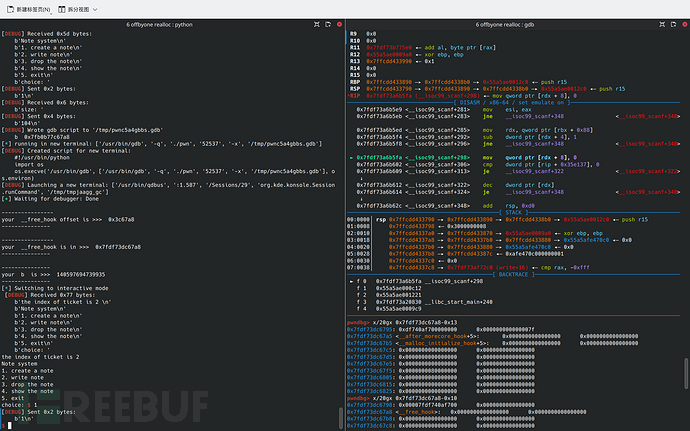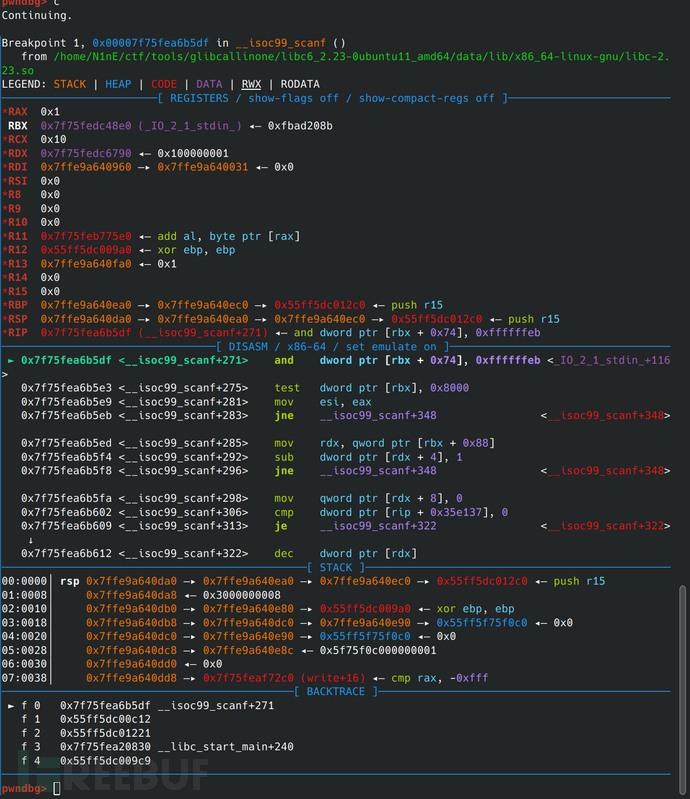0x00 写在前面
好久没来了哈,最近在参加某防科大的暑期学校还有练题目。
原文链接:https://www.freebuf.com/articles/endpoint/373258.html
欢迎来看我的博客(这几天搞好的):cnblogs.com/9man
谢谢大家支持!
本次阅读源码是本人第一次,算是一个全新的开始。本次看源码是为了调试roarctf的babyheap那道题目,wp写在独奏者2 序章那篇的0x04(在我个人博客里),为了看看为什么free_hook-0x13不能分配堆。
让我们先看看是怎么回事。

此时在fastbin构建了这样一个堆块,按理来说可以分配到的,但是——

这就不得不深挖一下了。
0x01 阅读前言和别名
搜索alias
weak_alias (__malloc_info, malloc_info)
strong_alias (__libc_calloc, __calloc) weak_alias (__libc_calloc, calloc)
strong_alias (__libc_free, __cfree) weak_alias (__libc_free, cfree)
strong_alias (__libc_free, __free) strong_alias (__libc_free, free)
strong_alias (__libc_malloc, __malloc) strong_alias (__libc_malloc, malloc)
strong_alias (__libc_memalign, __memalign)
weak_alias (__libc_memalign, memalign)
strong_alias (__libc_realloc, __realloc) strong_alias (__libc_realloc, realloc)
strong_alias (__libc_valloc, __valloc) weak_alias (__libc_valloc, valloc)
strong_alias (__libc_pvalloc, __pvalloc) weak_alias (__libc_pvalloc, pvalloc)
strong_alias (__libc_mallinfo, __mallinfo)
weak_alias (__libc_mallinfo, mallinfo)
strong_alias (__libc_mallopt, __mallopt) weak_alias (__libc_mallopt, mallopt)
weak_alias (__malloc_stats, malloc_stats)
weak_alias (__malloc_usable_size, malloc_usable_size)
weak_alias (__malloc_trim, malloc_trim)
weak_alias (__malloc_get_state, malloc_get_state)
weak_alias (__malloc_set_state, malloc_set_state)
发现__libc_malloc和__malloc是一个东西。
阅读前言(学英语了)
/* Malloc implementation(分配器/实施方案) for multiple(多种) threads without lock contention.
Copyright (C) 1996-2016 Free Software Foundation, Inc.
This file is part of the GNU C Library.
Contributed by Wolfram Gloger <wg@malloc.de>
and Doug Lea <dl@cs.oswego.edu>, 2001.
(多种没有锁链接的一种malloc的实施方法)
The GNU C Library is free software; you can redistribute(重新分配) it and/or
modify(修改) it under the terms(关系) of the GNU Lesser General Public License as
published by the Free Software Foundation; either version 2.1 of the
License, or (at your option) any later version.
(我们可以瞎改)
The GNU C Library is distributed in the hope that it will be useful,(希望有用)
but WITHOUT ANY WARRANTY(但是没有任何依据); without even the implied warranty of(甚至没有默示担保)
MERCHANTABILITY(适销性) or FITNESS FOR A PARTICULAR PURPOSE. See the GNU
Lesser General Public License for more details.
(有用但是没啥担保)
You should have received a copy of the GNU Lesser General Public
License along with the GNU C Library; see the file COPYING.LIB. If
not, see <http://www.gnu.org/licenses/>. */
//(应该收到了一个凭证,收不收都行对我来说)
/*
This is a version (aka ptmalloc2) of malloc/free/realloc written by
Doug Lea and adapted to multiple threads/arenas by Wolfram Gloger.
(这是ptmalloc2 的一个版本,这俩人写的)
There have been substantial(大量的,基本的,重要的) changes made after the integration(整合) into
glibc in all parts of the code. Do not look for much commonality
with the ptmalloc2 version.
(因为整合到glibc里所以改了很多,所以找不到太多和原本ptmalloc2版本共性)
* Version ptmalloc2-20011215
based on:
VERSION 2.7.0 Sun Mar 11 14:14:06 2001 Doug Lea (dl at gee)
(版本信息,2001年,够老了哈)
* Quickstart
(正片开始?草)
In order to compile(整合) this implementation(分配器), a Makefile is provided with
the ptmalloc2 distribution, which has pre-defined targets for some
popular systems (e.g. "make posix" for Posix threads).
(为了整合给了个makefile,匹配很多常用版本的系统)
All that is typically required with regard(认为) to compiler flags is the selection of
the thread(贯穿主线) package via defining one out of USE_PTHREADS, USE_THR or
USE_SPROC. Check the thread-m.h file for what effects this has.
Many/most systems will additionally require USE_TSD_DATA_HACK to be
defined, so this is the default for "make posix".
(解释了一下配置文件的方法)
* Why use this malloc?
This is not the fastest, most space-conserving(节省空间的), most portable(最轻便的,可移植的), or
most tunable(最和谐的) malloc ever written. However it is among the fastest
while also being among the most space-conserving, portable and tunable.
(他不是最节省空间,最可移植,嘴和写的,但是他是其中之一?离谱)
Consistent balance across these factors(因素) results in a good general-purpose
allocator for malloc-intensive programs.
(这些因素的持续的平衡,最终造就了这是一个给malloc深入细致的程序的通用性很好的分配方式。)
The main properties of the algorithms are:
(算法主要的性能)
* For large (>= 512 bytes) requests, it is a pure best-fit allocator,
with ties normally decided via FIFO (i.e. least recently used).
(对大的来说最合适不过了!)
* For small (<= 64 bytes by default) requests, it is a caching(缓冲)
allocator, that maintains(保持,维持) pools of quickly recycled chunks.
(对小的来说也不错!可以作为一个缓冲,循环利用堆块!)
* In between, and for combinations of large and small requests, it does
the best it can trying to meet both goals at once.
(在二者之间的也不错!因为他会尝试两个尽可能都达到)
* For very large requests (>= 128KB by default), it relies on system
memory mapping facilities, if supported.
(太大的话要看系统支不支持了呜呜)
For a longer but slightly out of date high-level description, see
http://gee.cs.oswego.edu/dl/html/malloc.html
You may already by default be using a C library containing a malloc
that is based on some version of this malloc (for example in
linux). You might still want to use the one in this file in order to
customize(定制) settings or to avoid overheads(额外开支) associated with library
versions.
(你可能是默认用的,也可能是想定制,也可能是图个免费。)
* Contents, described in more detail in "description of public routines(常规)" below.
Standard (ANSI/SVID/...) functions:
(标准函数来了)
malloc(size_t n);
calloc(size_t n_elements, size_t element_size);
free(void* p);
realloc(void* p, size_t n);
memalign(size_t alignment, size_t n);
valloc(size_t n);
mallinfo()
mallopt(int parameter_number, int parameter_value)
Additional functions:
(扩展的有这些)
independent_calloc(size_t n_elements, size_t size, void* chunks[]);
independent_comalloc(size_t n_elements, size_t sizes[], void* chunks[]);
pvalloc(size_t n);
cfree(void* p);
malloc_trim(size_t pad);
malloc_usable_size(void* p);
malloc_stats();
* Vital statistics:
(至关重要的统计数字)
Supported pointer representation: 4 or 8 bytes
Supported size_t representation: 4 or 8 bytes
Note that size_t is allowed to be 4 bytes even if pointers are 8.
You can adjust this by defining INTERNAL_SIZE_T
Alignment: 2 * sizeof(size_t) (default)
(i.e., 8 byte alignment with 4byte size_t). This suffices for
nearly all current machines and C compilers. However, you can
define MALLOC_ALIGNMENT to be wider than this if necessary.
Minimum overhead per allocated chunk: 4 or 8 bytes
Each malloced chunk has a hidden word of overhead holding size
and status information.
Minimum allocated size: 4-byte ptrs: 16 bytes (including 4 overhead)
8-byte ptrs: 24/32 bytes (including, 4/8 overhead)
When a chunk is freed, 12 (for 4byte ptrs) or 20 (for 8 byte
ptrs but 4 byte size) or 24 (for 8/8) additional bytes are
needed; 4 (8) for a trailing size field and 8 (16) bytes for
free list pointers. Thus, the minimum allocatable size is
16/24/32 bytes.
Even a request for zero bytes (i.e., malloc(0)) returns a
pointer to something of the minimum allocatable size.
The maximum overhead wastage (i.e., number of extra bytes
allocated than were requested in malloc) is less than or equal
to the minimum size, except for requests >= mmap_threshold that
are serviced via mmap(), where the worst case wastage is 2 *
sizeof(size_t) bytes plus the remainder from a system page (the
minimal mmap unit); typically 4096 or 8192 bytes.
Maximum allocated size: 4-byte size_t: 2^32 minus about two pages
8-byte size_t: 2^64 minus about two pages
It is assumed that (possibly signed) size_t values suffice to
represent chunk sizes. `Possibly signed' is due to the fact
that `size_t' may be defined on a system as either a signed or
an unsigned type. The ISO C standard says that it must be
unsigned, but a few systems are known not to adhere to this.
Additionally, even when size_t is unsigned, sbrk (which is by
default used to obtain memory from system) accepts signed
arguments, and may not be able to handle size_t-wide arguments
with negative sign bit. Generally, values that would
appear as negative after accounting for overhead and alignment
are supported only via mmap(), which does not have this
limitation.
Requests for sizes outside the allowed range will perform an optional
failure action and then return null. (Requests may also
also fail because a system is out of memory.)
Thread-safety: thread-safe
Compliance: I believe it is compliant with the 1997 Single Unix Specification
Also SVID/XPG, ANSI C, and probably others as well.
* Synopsis of compile-time options:
People have reported using previous versions of this malloc on all
versions of Unix, sometimes by tweaking some of the defines
below. It has been tested most extensively on Solaris and Linux.
People also report using it in stand-alone embedded systems.
The implementation is in straight, hand-tuned ANSI C. It is not
at all modular. (Sorry!) It uses a lot of macros. To be at all
usable, this code should be compiled using an optimizing compiler
(for example gcc -O3) that can simplify expressions and control
paths. (FAQ: some macros import variables as arguments rather than
declare locals because people reported that some debuggers
otherwise get confused.)
OPTION DEFAULT VALUE
Compilation Environment options:
HAVE_MREMAP 0
Changing default word sizes:
INTERNAL_SIZE_T size_t
MALLOC_ALIGNMENT MAX (2 * sizeof(INTERNAL_SIZE_T),
__alignof__ (long double))
Configuration and functionality options:
USE_PUBLIC_MALLOC_WRAPPERS NOT defined
USE_MALLOC_LOCK NOT defined
MALLOC_DEBUG NOT defined
REALLOC_ZERO_BYTES_FREES 1
TRIM_FASTBINS 0
Options for customizing MORECORE:
MORECORE sbrk
MORECORE_FAILURE -1
MORECORE_CONTIGUOUS 1
MORECORE_CANNOT_TRIM NOT defined
MORECORE_CLEARS 1
MMAP_AS_MORECORE_SIZE (1024 * 1024)
Tuning options that are also dynamically changeable via mallopt:
DEFAULT_MXFAST 64 (for 32bit), 128 (for 64bit)
DEFAULT_TRIM_THRESHOLD 128 * 1024
DEFAULT_TOP_PAD 0
DEFAULT_MMAP_THRESHOLD 128 * 1024
DEFAULT_MMAP_MAX 65536
There are several other #defined constants and macros that you
probably don't want to touch unless you are extending or adapting malloc. */
/*
void* is the pointer type that malloc should say it returns
*/
//到这上面就是一堆标准了。
0x02 找到malloc
void *__libc_malloc (size_t bytes)
{
mstate ar_ptr;
void *victim;
void *(*hook) (size_t, const void *)
= atomic_forced_read (__malloc_hook);
if (__builtin_expect (hook != NULL, 0))
return (*hook)(bytes, RETURN_ADDRESS (0));
//这里就是先看看hook有没有,有的话执行
arena_get (ar_ptr, bytes);
//搞一下arena的指针吧
victim = _int_malloc (ar_ptr, bytes);//arena的指针和申请大小,执行intmalloc函数,重点看看
/* Retry with another arena only if we were able to find a usable arena
before. */
if (!victim && ar_ptr != NULL)
{
LIBC_PROBE (memory_malloc_retry, 1, bytes);
ar_ptr = arena_get_retry (ar_ptr, bytes);
victim = _int_malloc (ar_ptr, bytes);
}
if (ar_ptr != NULL)
(void) mutex_unlock (&ar_ptr->mutex);
assert (!victim || chunk_is_mmapped (mem2chunk (victim)) ||
ar_ptr == arena_for_chunk (mem2chunk (victim)));
return victim;
}
libc_hidden_def (__libc_malloc)//这个玩意是延迟绑定用的,用到才绑定地址,节约资源
问题可能在intmalloc,或者chunk_is_mmapped (mem2chunk (victim))和ar_ptr == arena_for_chunk (mem2chunk (victim)));的检查。所以仔细过去看看。先去吃饭了等一下。
0x03 看看在哪报的错
b"*** Error in `./pwn': malloc(): memory corruption (fast): 0x00007fafbedc67a5 ***\n"
*** Error in `./pwn': malloc(): memory corruption (fast): 0x00007fafbedc67a5 ***
然后去源码找一下相关的。
static void *
_int_malloc (mstate av, size_t bytes)//从vscode上面可以找到
{
INTERNAL_SIZE_T nb; /* normalized request size (标准请求的大小)*/
unsigned int idx; /* associated bin index (bin的索引)*/
mbinptr bin; /* associated bin (分配的bin)*/
其大小
mchunkptr victim; /* inspected/selected chunk (收集的堆)*/
INTERNAL_SIZE_T size; /* its size (收集堆的大小)*/
int victim_index; /* its bin index (堆的索引??)*/
//上面是收集堆块
mchunkptr remainder; /* remainder from a split (分裂剩余的部分)*/
unsigned long remainder_size; /* its size (和其大小)*/
unsigned int block; /* bit map traverser */
unsigned int bit; /* bit map traverser */
unsigned int map; /* current word of binmap (一个当前一个横跨)*/
mchunkptr fwd; /* misc temp for linking */
mchunkptr bck; /* misc temp for linking (fd和bk)*/
const char *errstr = NULL;
/*
Convert request size to internal form by adding SIZE_SZ bytes
overhead plus possibly more to obtain necessary alignment and/or
to obtain a size of at least MINSIZE, the smallest allocatable
size. Also, checked_request2size traps (returning 0) request sizes
that are so large that they wrap around zero when padded and
aligned.
*/
checked_request2size (bytes, nb);
这个是函数前面的一点定义。
if ((unsigned long) (nb) <= (unsigned long) (get_max_fast ()))
{
idx = fastbin_index (nb);//获取fastbin的索引
mfastbinptr *fb = &fastbin (av, idx);
mchunkptr pp = *fb;
do
{
victim = pp;
if (victim == NULL)
break;
}
while ((pp = catomic_compare_and_exchange_val_acq (fb, victim->fd, victim))
!= victim);
if (victim != 0)//如果有分配
{
if (__builtin_expect (fastbin_index (chunksize (victim)) != idx, 0))
/*如果__builtin_expect (fastbin_index (chunksize (victim)) != idx, 0)为真则报错
找到堆的大小,然后找bin的索引,和0一起传入了__builtin_expect。
所以去看看__builtin_expect
loading……
这个玩意是用来优化代码的,一会会贴一下网址,是在gcc里
如果第二个参数是1,则通常执行if的内容,是0的话通常执行else。
(第二个参数其实就是期望的意思,函数是建立时的期望)
这样可以节约jmp指令,提升效率。
他真的我哭死,好相信我们,认为我们都会正常分配去执行else
可是我们在利用他的信任……也就是说报错说明第一个参数返回1了。
也就是说fastbin_index (chunksize (victim)) 和idx不相等。那我们去看看咋回事吧!
总结来说,就是我这个大小的堆的索引和我想申请的不一样。
也就是bin应该存的大小和实际的大小不一样。
*/
{
errstr = "malloc(): memory corruption (fast)";
errout:
malloc_printerr (check_action, errstr, chunk2mem (victim), av);
return NULL;
}
check_remalloced_chunk (av, victim, nb);//否则正常分配
void *p = chunk2mem (victim);
alloc_perturb (p, bytes);
return p;
}
}
经过一波分析,发现报错是因为,bin应该存的大小和实际的大小不一样。但是显然这不是我们的问题,因为伪造0x7f已经很熟悉了,申请0x68,结果发现再去gdb调试是在申请的时候那段内存突然变成0了,所以才会报错。

0x04 为什么变成0了呢?
我们打断点看看。
pwndbg> watch *0x7f97f2fc67a8 -0x13
Hardware watchpoint 2: *0x7f97f2fc67a8 -0x13
这么久终于用到watch命令了,观察这个地址数据有没有变化。(没啥用,求大佬教教,这个当一个疑问吧)

调了很久终于找到是这里搞的了。
看看rdx怎么来的。
我再看看为什么malloc_hook不受影响。

注意看rdx,不管是fastbin attack到mallochook还是freehook都是一样的。
结果发现这个地方就是用来存参数用的。我们再看看存的是什么。然后发现不管输入什么这里都会变成……1。最后用0覆盖掉。
再运行之后发现每次调用__isoc99_scanf那个地方会被恢复,也就是说这个地址刚好是存有相关参数的地方。
运行的过程中0x0000000100000001 变成0x0000000100000000,执行完__isoc99_scanf后,
0x7fe64dfc6790: 0x0000000100000001 0x00007fe64e40f700(这里是freehook的地址减去0x18)
全部变为0,我认为这是因为存取了某些参数。
0x05 探秘__isoc99_scanf
int
attribute_compat_text_section
__nldbl___isoc99_scanf (const char *fmt, ...)
{
va_list arg;
int done;
va_start (arg, fmt);
done = __nldbl___isoc99_vfscanf (stdin, fmt, arg);
va_end (arg);
return done;
}
这是__isoc99_scanf的源码,发现没有什么设置参数的东西,但是调用了__nldbl___isoc99_vfscanf。
int
attribute_compat_text_section
__nldbl__IO_vfscanf (FILE *s, const char *fmt, _IO_va_list ap,
int *errp)
{
int res;
set_no_long_double ();
res = _IO_vfscanf (s, fmt, ap, errp);
clear_no_long_double ();
return res;
}
这是 __nldbl___isoc99_vfscanf的源码,发现可疑函数两个,set_no和clear_no。
然后发现了惊天秘密!
#define set_no_long_double() \
__libc_cleanup_push (__nldbl_cleanup, NULL); __no_long_double = 1
#define clear_no_long_double() \
__no_long_double = 0; __libc_cleanup_pop (0)
/* Compatibility with IEEE double as long double.
IEEE quad long double is used by default for most programs, so
we don't need to split this into one file per function for the
sake of statically linked programs. */
其实大致就是前面是让他为1并且设置一个函数,后面是让他为0,并且清理掉。破案了破案了。
问问chat哥:
感谢提供更多代码片段,让我们来解释一下这些宏和相关的代码:
-
set_no_long_double()宏: 这个宏用于设置一个名为 __no_long_double的标志,将其值设置为1,并且注册了一个清理函数 __nldbl_cleanup。在设置 __no_long_double为1的同时,会调用 __libc_cleanup_push函数,将 __nldbl_cleanup添加到清理函数栈中。这意味着当函数返回或执行 __libc_cleanup_pop时,会调用 __nldbl_cleanup来清理资源。
-
clear_no_long_double()宏: 这个宏用于将 __no_long_double标志的值设置为0,并且通过调用 __libc_cleanup_pop函数从清理函数栈中弹出清理函数。这样做是为了确保在函数返回或退出之前,能够正确地重置 __no_long_double的值。
-
注释部分: 这部分注释提到与 IEEE 双精度浮点数作为长双精度浮点数的兼容性。它指出,对于大多数程序,默认情况下使用 IEEE 四倍精度浮点数作为长双精度浮点数。并且提到为了静态链接的程序的缘故,不需要为每个函数拆分为单独的文件。
综合以上信息,可以推断这段代码在处理长双精度浮点数时进行了一些处理,可能是为了兼容性或特定环境下的优化。__no_long_double标志可能用于控制是否使用长双精度浮点数,而 __libc_cleanup_push和 __libc_cleanup_pop则用于确保在函数返回时正确地处理相关资源。
0x06 总结
总结就是free_hook改不了,因为调用scanf的时候会进行一系列操作把我们的fakechunk的头部(尤其是size的位置)清零,直到下一次调用scanf的时候又恢复有清理函数,这也是为什么我们能看到fakechunk——因为我们是按c到那里停住,而停住的时候正是用scanf读取数字的过程,这个时候清理函数是存在的……
第一次读源码,太牛了,有点震撼背后的原理,真有意思。一直从早上干到下午六点,也就是现在。
还有点感冒,中午没睡好,一会去拿某人买的药,嘿嘿。
0x07 尾声
(此处应有流浪地球丫丫的bgm)
这里可能存在一些涉及长双精度浮点数的处理逻辑,但没有足够的上下文信息来进一步解释代码的用途和目的。如果您有完整的代码,可以进一步查看相关代码和调用处,以理解更多细节。同时,您还可以参考相关的文档或联系代码的原作者或维护人员,以获取更准确的解释和用途说明。
 发表于 2023-7-31 22:20
发表于 2023-7-31 22:20
 发表于 2023-7-31 22:34
发表于 2023-7-31 22:34
 发表于 2023-7-31 23:04
发表于 2023-7-31 23:04
 发表于 2023-7-31 23:53
发表于 2023-7-31 23:53
 发表于 2023-8-1 00:16
发表于 2023-8-1 00:16
 发表于 2023-8-1 07:19
发表于 2023-8-1 07:19
 发表于 2023-8-1 09:26
发表于 2023-8-1 09:26